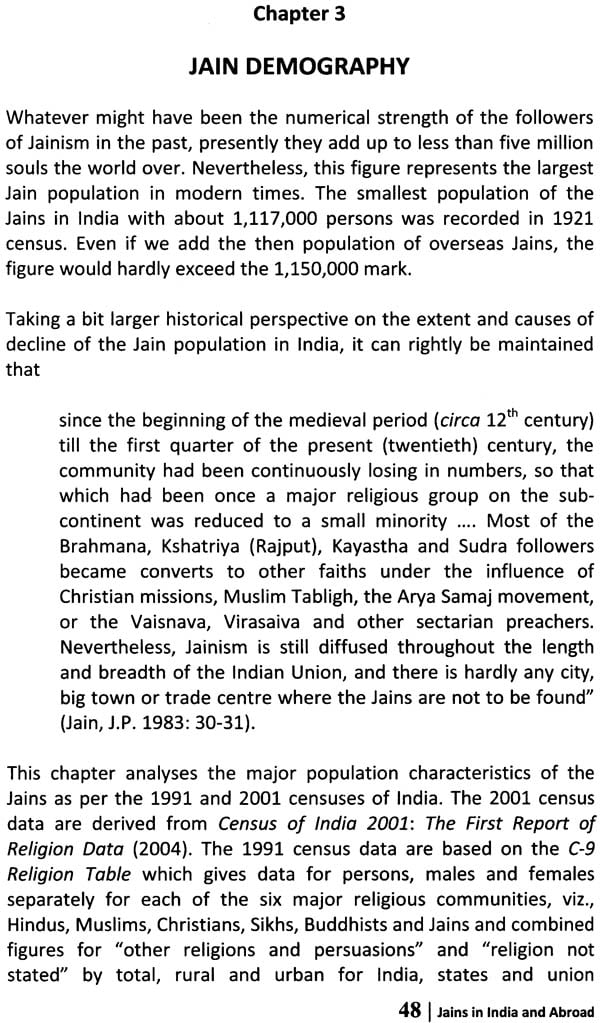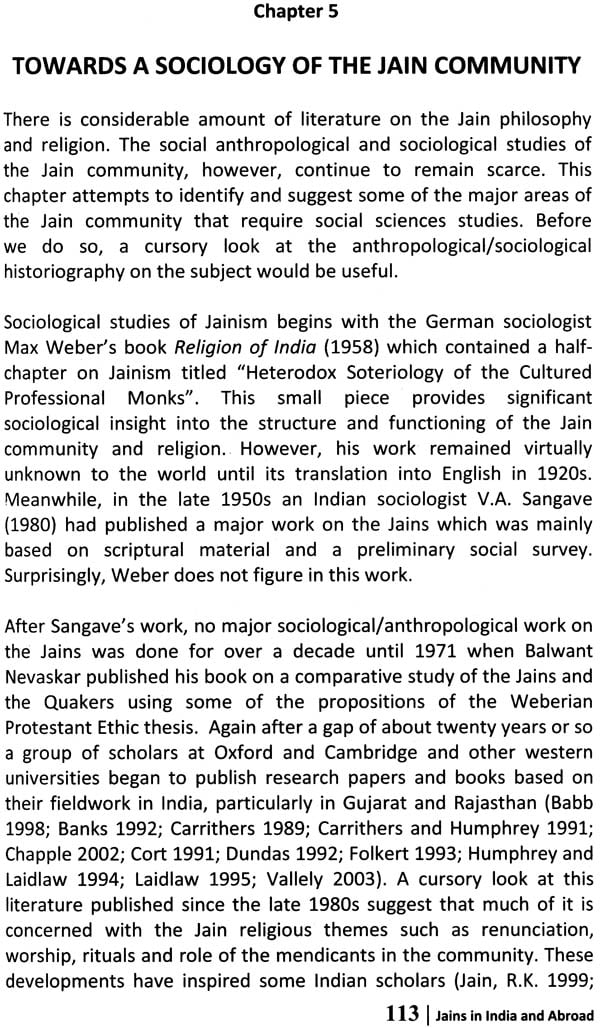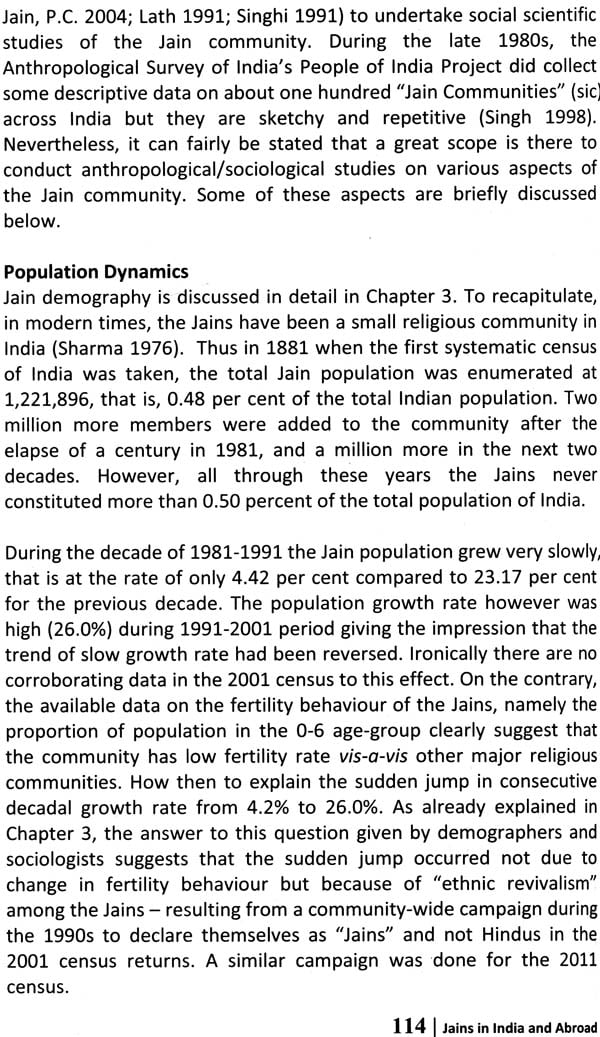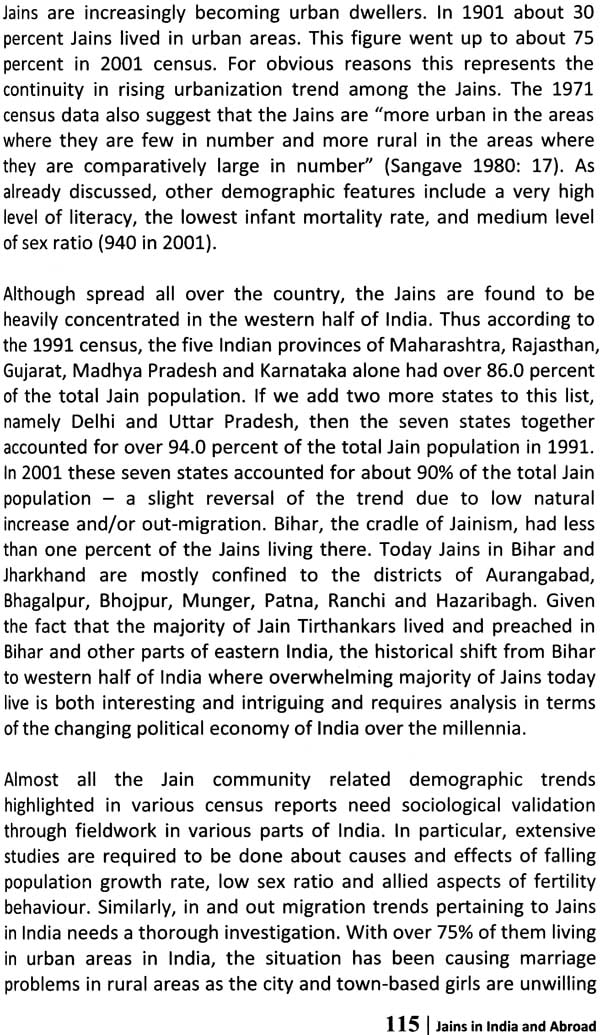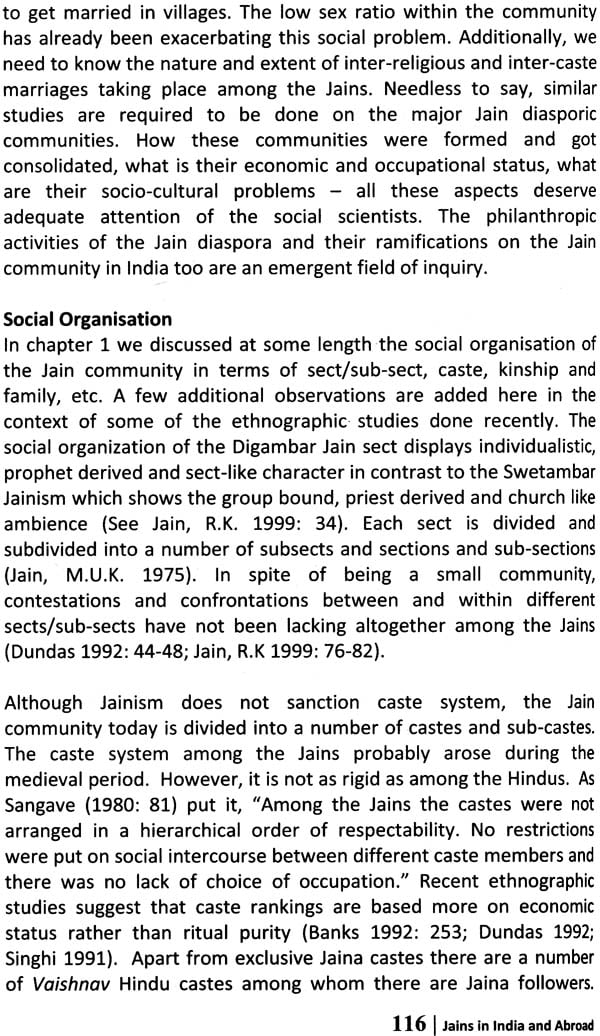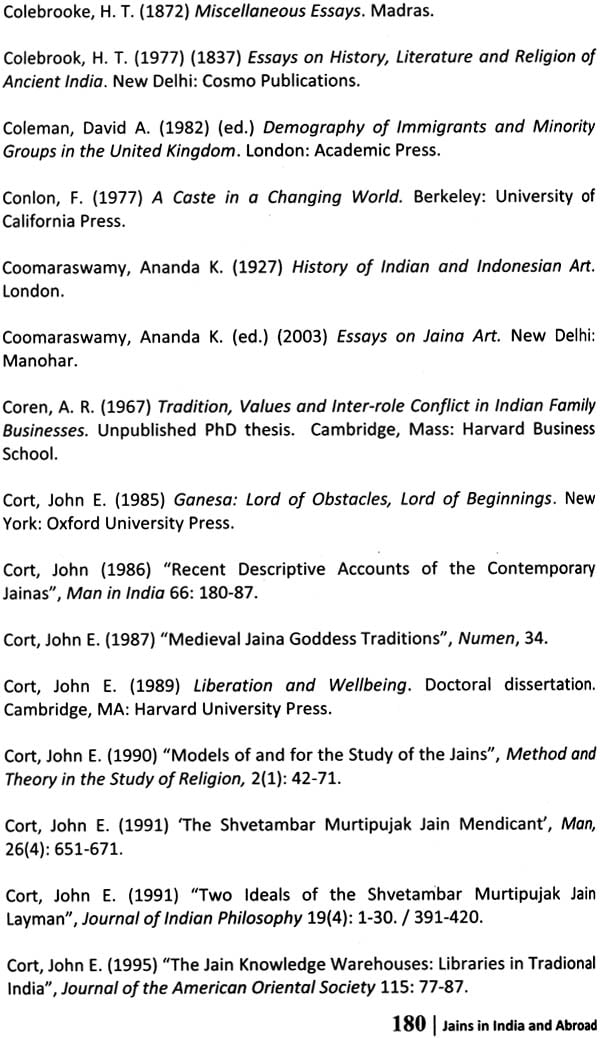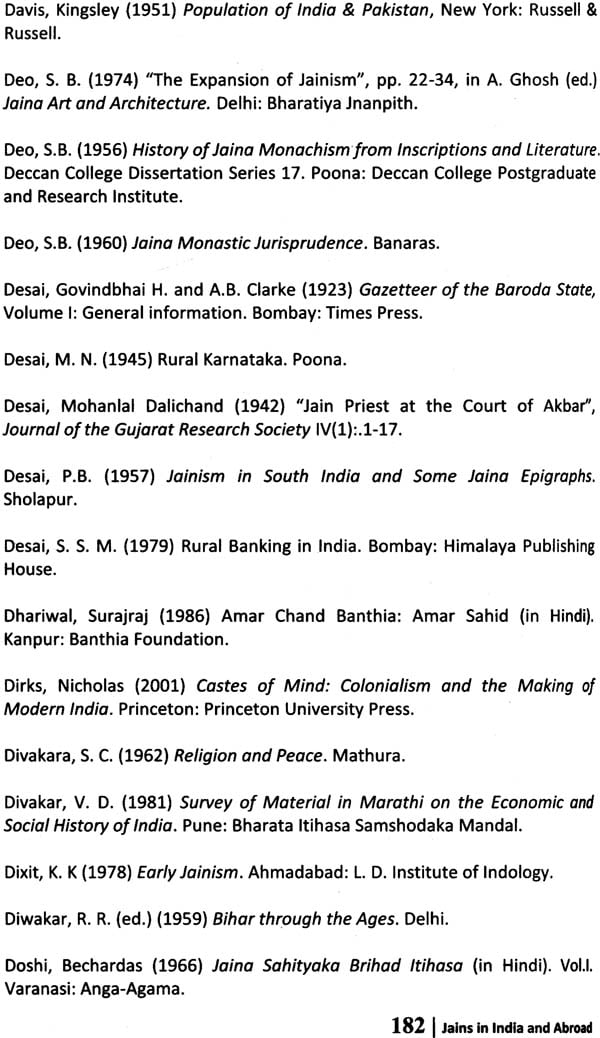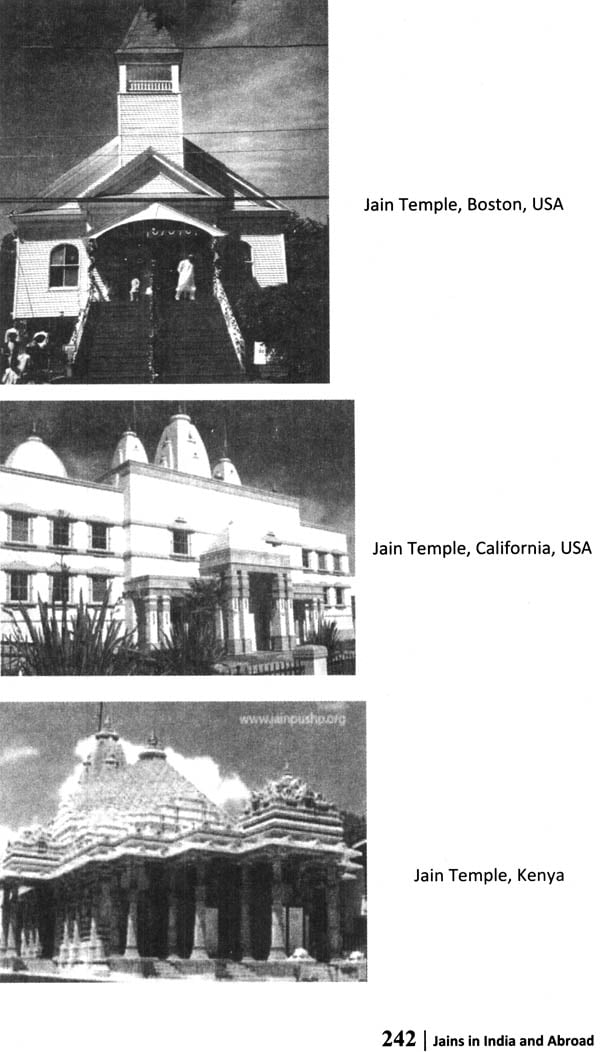
Jains in India and Abroad (A Sociological Introduction)
Book Specification
| Item Code: | NAL559 |
| Author: | Prakesh C. Jain |
| Publisher: | International School for Jain Studies |
| Language: | English |
| Edition: | 2011 |
| ISBN: | 8186715797 |
| Pages: | 216 (31 B/W and 1 color Illustrations) |
| Cover: | Paperback |
| Other Details | 8.5 inch x 5.5 inch |
| Weight | 320 gm |
Book Description
About the Book
This volume is a comprehensive and systematic compendium of authentic data on the Jain minority community in India and abroad. Although there have been earlier compilations about the Jains, What distinguishes Prof. Prakash Jain’s effort is the updated demographic profile and an entire chapter on the Jain diaspora. Its concluding chapter furnishes an excellent sociological analysis, encompassing almost all significant dimensions of the Jain community. With a number of tables, figures, maps, photographs and appendices, it is a commendable and painstaking undertaking that is bound to remain a modern classic its field for several decades to come.
Ravindra K. Jain, Former Prof. of Anthropology & Dean, School of Social Sciences, Jawaharlal Nehru University, New Delhi.
Today’s Jain communities face issues that are best dealt with by sociological investigation. Regrettably, there are few such books. Here Dr. Prakash Jain engages readers by asking precisely there unquestioned issues as motivation for writing this book. The personality and interests of the author shine through and engage the readers as Dr. Jain sets out extensive quantitative data in a clear and accessible analysis. He thereby articulates promising areas of inquiry for future studies of the Jains.
This book will inspire no end questions for further research on part of its readers. Dr. Jain contextualizes today’s Jain communities with recent work by Jain studies scholars, India census data and a series of observations about historic and current transformations of popular Jains practices. This enables Dr. Jain to make important observations on emerging trends to gender issues, the impacts of ongoing divisions among the Jains and the Jain diaspora. Interested readers can thereby better understand the apparent discontinuities and paradoxical differences between Jains’ practices and what Jains ‘preach’ to non-Jains. Academic readers will find pinpoint directions for what sorts of sociological studies are not only waiting to be done, but are very feasible for scholars to complete.
Nathan B.R. Loewen, Ph.D., Professor of Humanities, CEGEP Vanier college, Montreal.
Preface
Every since I was exposed to Max Weber’s Protestant Ethic thesis during my M.A. (Sociology) studies programme, I had more or less decided to test the thesis by myself writing a dissertation on Jainism and the Jains. Reading Weber’s insightful analysis of Jainism contained Religion of India further strengthened my resolve to do that. An award of Canadian commonwealth Scholarship for Ph. D. Programme in the late 1970s that landed me at the Carleton University of Ottawa kept my resolve intact, where I wrote a term paper on the Jains for a course on Sociology of Religion. Unfortunately it could not go further for a number of reasons. Instead my academic interest got shifted to Indian Diasporic Studies-an academic subject that eventually earned me a Ph. D. Degree. Nevertheless, an updated and thoroughly revised version of that paper constitutes Chapters 5 of the book.
The book begins with an introduction of Jainism with its brief history in different parts of India and the sects and sub-sects that developed within it during the past two thousand years. Some basic social structural features such as family, kinship and marriage are also mentioned alongwith a brief note on food, festivals and places of pilgrimage of jains. Chapter 2 highlights the salient features of jain philosophy in terms of its metaphysics, ontology, epistemology and ethics which have been the basis of the jain way of life for centuries. At the end, the Jain way of life and its practicality in diasporic context as well as India is critically examind.
During the mid-1990s, the Census of India 1991 data revealed a relatively slow population growth rate of the jains vis-a-vis other five major religious communities of India, namely Hindus, Muslim, Sikhs, Christians and Buddhists. The findings were reported widely in the media that rekindled my interest to probe the problem further. Subsequently I wrote a brief article entitled “The Jains in the 1991 Census of Indian” that I sent for publication to prominent jain journal in India. The editor of the journal expressed his inability to publish his inability to publish the same saying “the committee does not want to publish it”. I still fail to understand why, give the fact the an article based on the 1981 census date was earlier published by the same journal. My best guess is that perhaps the journal did not want to highlight the suddenly emerged situation of low fertility behaviour among the jains in the 1991 census data. Meanwhile, the 2001 Census data on religious communities in India were also available, which prompted me to revise the article in the light of the new data. Chapter 3 in the present volume is an outcome of that exercise.
A large number of Jains are either ignorant about the size of their community and its other demographic aspects, or have serious misgivings about it. They often seem to nurse grievances against the Census of India authorities for under-estimating the Jain population. Many of them suggest at the same time that there are no less than 10 million jains in Indian notwithstanding such a wild claim, the census date clearly point towards a figure of no more than 405 million jains in Indian. The 1991and the 2001 Census data also underline the fact of low fertility behaviour among the jains.
The 2001 Census data further underlined the fact of ethnic revivalism that got intensified among them during the 1990s, as a result of which about 600,000 jains “lost” to the Hindus returned back to the community. The rise of the Hindu fundamentalism in India since the late 1980s, demolition of the Babri Masjid in 1992, and the growing ethnocentrism among other communities might have been responsible for this phenomenon among the jain,who otherwise have been very well integrated into the mainstream of the Indian society. It would be interesting to note the outcomes of the 2011 Census that might tell us whether the process is over or there is more to it.
Having been engaged in the field of India diaspora in general for the past three decades, it was natural for me to pay some attention to the jain diaspora, which currently is estimated at around quarter of million, and is growing steadily. Not only numerous socio-cultural associations have sprung up within the Jain diaspora, a number of jain temples have been constructed in those countries where there is a sizeable jain community. Lately, Jain diaspora has been in the process of projecting Jainism and the jain way of life as rational and scientific. Towards this goal some literatures is being produced that put emphasis on the Jainist principles of ahimsa (non-violence), aparigraha (non-possession) and anekant (relativism). Promotion of vegetarianism as well as Jainism as an area of serious academic research appears to be the twin goals of diasporic Jain activism.
The Jain diaspora has begun to exert its influence on the Jains in India. In the process the Jains in India are also trying to reach out to their counterparts abroad. These mutually reinforcing linkasges can best be seen in the activities of such associations as the Federation of the Jaina Associations in North America, the Jain International Trade Organisation, Mumbai and Shree Bharatvarshiya Digambara Jain Mahasabha, Delhi, They have been active in the fields of not only trade and commerce but have also been propagating Jainism around the world. The Jain Diaspora and some of its activities are highlighted in Chapter 4. An earlier version of this Paper was presented at Bangalore at a conference on the “Diversity in Indian Diaspora” (Jain 2011).
The book contains a large bibliography with special reference to Jain philosophy and religion, history, demography, anthropology, sociology and other social sciences. Needless to say, the five chapters and a bibliography constitute only a small book-essentially an outline of the theme “Jains in India and Abroad”. As mentioned above, the genesis of the book lies in differential circumstances over a long period of time, and therefore a certain amount of repetition of contents has been inevitable. There might be a number of other shortcomings in the book. Nevertheless, encouragement received from various quarters finally prompted to put together the book. I earnestly hope that it would be useful to the general readers as well as the scholars.
I am grateful to Prof. Nathan R.B. Loewen of Vanier College, Montreal for reading earlier drafts of the manuscript and for making extensive criticism and comments towards improving the same. Some of the Ph. D. Scholars working under my supervision, particularly kundan Kumar, Jaffar Ali khan, Rakesh K. Ranjan, Rajiv Kumar, Rajeevan Kunnath, Navendu Shekhar and Ms. Rajni Bala helped me in a number of ways in finalizing the book. Ms. Chanchal jain and Mr. Sushil Jana of International School for Jain Studies composed the book on Page Maker and assisted in designing the cover page with great enthusiasm. I am thankful to all of them. Thanks are also due to Dr. Shugan C. Jain, India-Director of International School for Jain Studies, New Delhi for promptly accepting the manuscript for publication on behalf of the School.
And finally, the book is dedicated to the fond memories of my father Shri Ratna Chand Jain and my father-in law Shri C.K. Saxena who, in spite of their different socio-economic and religious backgrounds, had some common “Jaintlemanly” qualities. The book also purports to be a gift to my wife Dr. Renu Saxena, and our daughters Ms. Rashi Prakash and Ms. Sanskriti Prakash who might learn about the Jains a little more systematically than had so far been possible for me by telling them in bits and pieces.
Contents
| Preface | ix | |
| List of Tables | xii | |
| List of Figures | xiii | |
| List of Maps | xiii | |
| List of Plates | xiv | |
| Chapter 1: | The Jains | 1-22 |
| Jainism and its Origin & Growth | ||
| History of Jainnism | ||
| Sects in Jainism | ||
| Jain Social Organisation | ||
| Food, Festivals and Pilgrimage | ||
| Jains’ Contribution to the Indian Culture & Society | ||
| Concluding Remarks | ||
| Chapter 2: | Jain Way of Life | 23-47 |
| Jain Philosophy | ||
| Jain Ethics | ||
| Householder’s Code of Conduct | ||
| Code of Conduct for Ascetics | ||
| Practicality of Jain Asceticism for Laity | ||
| Jain way of Life: Diasporic Context | ||
| Concluding Remarks | ||
| Chapter 3: | Jain Demography | 48-85 |
| Population Size | ||
| Population Growth Rate | ||
| Population Variation by States/Union Territories | ||
| Concentration in Seven States/UT | ||
| Urbanisation | ||
| Sex Ratio | ||
| Literacy, Work Participation and Occupation | ||
| Concluding Remarks | ||
| Chapter 4: | Jain Diaspora and its Linkages with Indian | 86-112 |
| East Africa | ||
| West Asia | ||
| South and South- East Asia | ||
| United Kingdom | ||
| United States of America | ||
| Canada | ||
| Diaspora-Homeland Linkages | ||
| Federation of Jain Associations in North America | ||
| Jain International Trade Organisation | ||
| Jain Social Groups’ Federation | ||
| International School for Jain Studies | ||
| Bharatvarshiya Digambar Jain Mahasabha | ||
| Siddhachalam and Sarvodaya Teerth | ||
| Bhagwan Mahavir Chair for Jain Studies | ||
| Concluding Remarks | ||
| Chapter:5 | Towards a Sociology of the Jain Community | 113-139 |
| Population Dynamics | ||
| Social Organisation | ||
| Economic Status | ||
| Minority Status | ||
| Political Status | ||
| Dualistic Organisation | ||
| Religious Ethic | ||
| Segmental Orientation | ||
| Inter-Ethnic Relations | ||
| Concluding Remarks | ||
| Appendices | ||
| I | Population of India by Religion Communities, 2001 | 140-148 |
| II | Distribution of Population of Indian Religious | |
| Communities by Caste Categories. | 148 | |
| III | Text of the Letter to the Prime Minister of India for the enactment of Jain Marriage Act from the national president of Shree Bharatvrsheeya Digamber Jain Mahasabha, Delhi | 149-150 |
| IV | A list of Prominent Jain public Figures of the Twentieth Century | 151-158 |
| V | A List of Jain Associations Abroad | 159-169 |
| Bibliography | 170-230 | |
| Glossary | 231-238 | |
| Plates | 239-242 | |
| Index | 243-246 |
